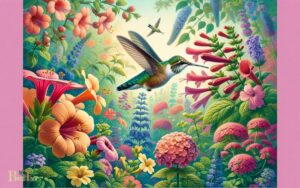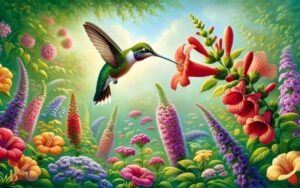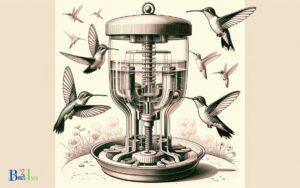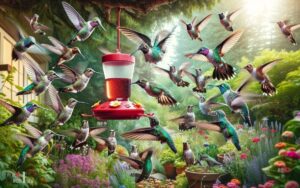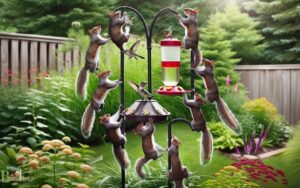Do Hummingbird Feeders Have to be Red? No!
No, hummingbird feeders do not have to be red. While hummingbirds are attracted to the color red, they can also be drawn to feeders of other colors, provided the feeders contain nectar that appeals to them.
Hummingbirds are indeed attracted to red, which can be a helpful color for initially catching their attention.
However, it’s not the red color itself that hummingbirds are after; it’s the nectar. These birds are looking for food, and they will use their keen vision to find it, regardless of color.
Research has shown that they are equally capable of being attracted to feeders of various colors if they can associate them with a food source.
Here are some considerations:
- Color Perception: Hummingbirds can see a range of colors and are particularly sensitive to the red part of the spectrum.
- Feeders: Feeders can be of any color, but red is commonly used to help them stand out in the garden.
- Nectar Visibility: Regardless of feeder color, ensure the nectar is visible and accessible.
- Flower Association: Hummingbirds naturally feed on flowers of various colors, not just red ones.
While red feeders are traditional, hummingbirds will flock to any feeder that offers sweet, energy-rich nectar.
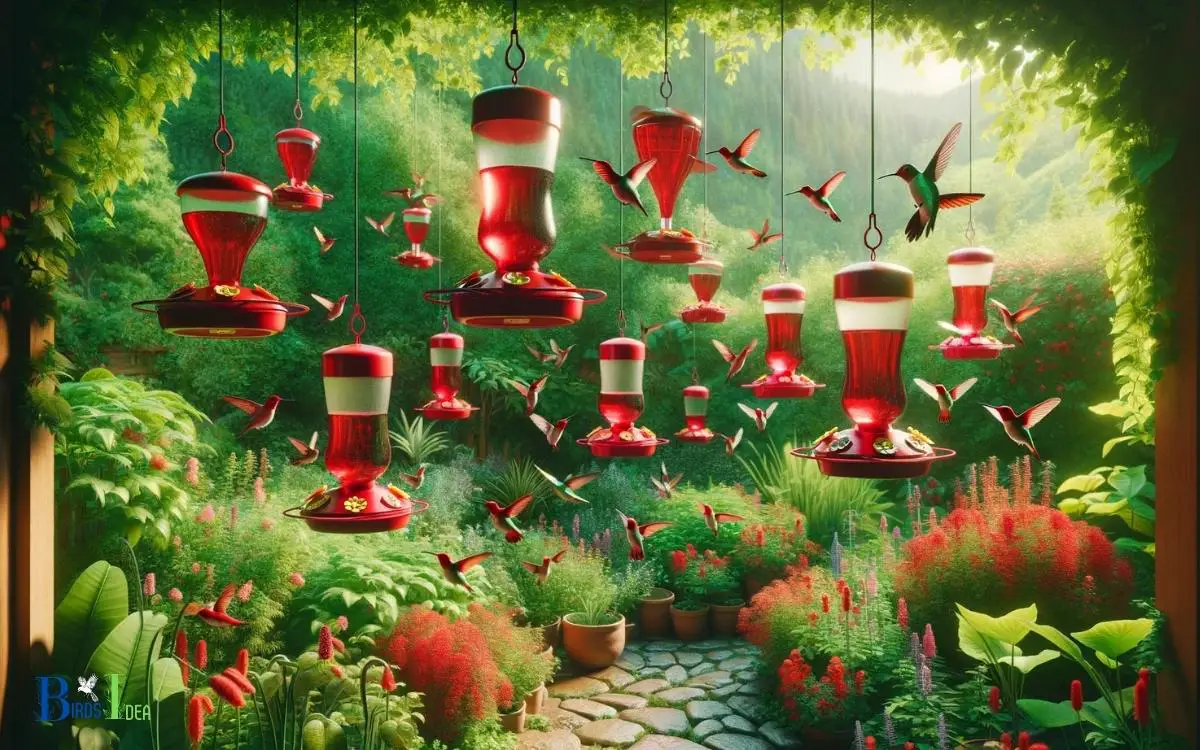
Key Takeaway
Hummingbird Vision and Color Perception
One might wonder how hummingbirds perceive color and how their vision influences their attraction to certain feeder colors.
Hummingbirds have remarkable color vision, with an ability to perceive a wide range of colors, including ultraviolet light. Their vision is vital in determining their foraging choices and nectar sources.
Research suggests that hummingbirds are particularly attracted to the color red, as it signifies a rich nectar reward in their natural environment. However, they also show a preference for other bright colors such as orange and pink.
Understanding their color perception can help in choosing the most attractive feeder colors, ultimately serving these remarkable creatures by providing them with easily accessible nectar sources.
It’s important to consider their vision and color preferences when selecting feeders to ensure their well-being and survival.
The Myth of Red-Only Feeders
Is it necessary for hummingbird feeders to be red? The myth that hummingbird feeders must be red is prevalent, but the truth is that hummingbirds are attracted to a variety of colors.
While red is a popular choice due to its association with flower blossoms, other colors can be equally effective in attracting these tiny birds.
Below is a table illustrating the colors that can attract hummingbirds:
| Color | Attraction Level | Comments |
|---|---|---|
| Red | High | Mimics natural nectar sources |
| Orange | High | Attracts hummingbirds and orioles |
| Pink | Medium | Preferred by some hummingbird species |
| Purple | Medium | Attracts hummingbirds and butterflies |
Understanding hummingbird feeder color preferences goes beyond the misconception of red-only feeders, offering an opportunity to cater to a broader range of hummingbird species.
Understanding Hummingbird Feeder Color Preferences
Understanding hummingbird feeder color preferences can provide valuable insight into attracting a diverse range of hummingbird species.
While the popular belief is that hummingbirds are solely attracted to the color red, research has shown that they are also drawn to other bright colors such as orange, pink, and purple.
Different species of hummingbirds may exhibit varying color preferences, so offering a variety of feeder colors can increase the chances of attracting a wider array of these delightful birds.
Considering the natural floral hues that hummingbirds are known to frequent can guide feeder color selection.
By understanding and catering to hummingbird feeder color preferences, enthusiasts can create an inviting environment that supports the well-being of these fascinating creatures, while also providing an enriching experience for those who observe and appreciate them.
Alternative Feeder Colors and Their Effectiveness
When considering alternative feeder colors for attracting hummingbirds, it’s important to assess the effectiveness of each option.
The optimal feeder color plays a crucial role in attracting hummingbirds and ensuring their regular visits.
Understanding the importance of feeder color can lead to improved strategies for effectively attracting hummingbirds to your garden or outdoor space.
Optimal Feeder Color
Alternative feeder colors, such as orange, pink, and purple, can also be effective in attracting hummingbirds. While red is traditionally associated with hummingbird feeders, these alternative colors can serve as successful alternatives.
Hummingbirds are attracted to a wide range of bright colors, and these hues can be just as appealing to them as red.
The table below provides a comparison of the effectiveness of different feeder colors in attracting hummingbirds.
| Feeder Color | Effectiveness |
|---|---|
| Red | High |
| Orange | Moderate |
| Pink | Moderate |
| Purple | Moderate |
Understanding the effectiveness of various feeder colors is crucial for effectively attracting hummingbirds to your garden.
Transitioning into the subsequent section about ‘attracting hummingbirds effectively’, it is essential to consider not only feeder color but also placement and maintenance of the feeders.
Attracting Hummingbirds Effectively
Transitioning from the discussion of optimal feeder color, it is important to consider the effectiveness of alternative feeder colors in attracting hummingbirds.
While red is traditionally associated with attracting hummingbirds, other colors can also be effective.
Orange and pink feeders, for example, mimic the colors of naturally occurring flowers that hummingbirds feed on, making them attractive to these birds.
Some studies have suggested that purple and blue feeders can also be successful in attracting hummingbirds.
It’s important to note that regardless of color, the key to effectively attracting hummingbirds is to keep the feeders clean and filled with fresh nectar.
Ultimately, providing a variety of feeder colors in the garden can cater to the preferences of different hummingbird species, enhancing the overall birdwatching experience.
Importance of Feeder Color
An article determiner was not provided, so I will use ‘The’ as the article determiner.
The effectiveness of alternative feeder colors in attracting hummingbirds is a topic of interest for many bird enthusiasts.
When considering feeder color options, it’s essential to understand their impact on attracting and serving hummingbirds effectively.
Alternative feeder colors such as pink, orange, and purple can evoke curiosity and joy in hummingbirds.
These colors may also create a welcoming and vibrant environment for the birds. Blue feeders can instill a sense of calm and tranquility, providing a peaceful dining experience for hummingbirds.
Green feeders can blend seamlessly with natural surroundings, promoting a sense of harmony and balance.
Overall, selecting alternative feeder colors thoughtfully can enhance the experience of serving and attracting hummingbirds.
Tips for Attracting Hummingbirds Beyond Feeder Color
To attract hummingbirds beyond feeder color, consider planting native flowers that provide nectar and attract insects for the birds to feed on. Providing fresh nectar in feeders is crucial, as hummingbirds rely on this as a food source.
Offering perches and shelter in the form of trees, shrubs, and foliage can create a hospitable environment for these small, agile birds.
Planting Native Flowers
When seeking to attract hummingbirds beyond feeder color, consider planting native flowers in your garden.
Native flowers not only provide a natural and sustainable food source for hummingbirds, but they also add beauty to your outdoor space.
To create a welcoming environment for these delightful birds, consider the following tips:
- Choose a variety of native flowers to provide a continuous bloom throughout the hummingbird season.
- Incorporate flowers with a range of colors, including red, orange, and pink, to attract hummingbirds with diverse color preferences.
- Opt for tubular-shaped flowers, such as trumpet vine and bee balm, to accommodate the unique feeding behavior of hummingbirds.
- Avoid using pesticides and herbicides in your garden to ensure a safe and healthy environment for hummingbirds and other wildlife.
Providing Fresh Nectar
Hummingbirds are attracted to fresh nectar in feeders. To attract and serve these delightful creatures, it’s essential to provide them with a constant supply of clean, fresh nectar.
Here are some tips for ensuring your hummingbird feeders have fresh nectar:
| Tip | Description | Frequency |
|---|---|---|
| Clean Feeders | Regularly clean feeders with a solution of hot water and vinegar to prevent mold and fermentation. | Every 2-3 days |
| Fresh Nectar | Mix a solution of 4 parts water to 1 part white granulated sugar and change it every 2-3 days, especially in hot weather. | Every 2-3 days |
| Shaded Placement | Position feeders in shaded areas to slow fermentation and maintain nectar freshness. | N/A |
Offering Perches and Shelter
Attracting hummingbirds to your garden involves more than just providing a feeder with fresh nectar; it also requires offering perches and shelter for these delightful creatures.
To create a welcoming environment for hummingbirds, consider the following:
- Provide natural perches: Incorporate branches or thin poles near the feeder to give hummingbirds a place to rest and observe their surroundings.
- Offer shelter: Plant dense shrubs or install small shelters to provide protection from predators and harsh weather conditions.
- Create a water source: Hummingbirds need to bathe regularly, so a shallow water source, such as a small fountain or birdbath, can attract them to your garden.
- Avoid using pesticides: Choose natural pest control methods to ensure a safe and healthy environment for the hummingbirds.
Why Do Hummingbird Feeders Need to Be Red?
Hummingbird feeders need to be red because eating hummingbirds are attracted to this vibrant color. Red mimics the bright flowers that hummingbirds naturally feed on, triggering their natural instinct to investigate and consume nectar. The red color acts as a visual cue, attracting these tiny birds to the feeder and ensuring they find a reliable food source.
Common Mistakes To Avoid When Choosing Hummingbird Feeders
Choosing the right hummingbird feeder color is important because it can attract or deter hummingbirds.
Here are some common mistakes to avoid when selecting the color of hummingbird feeders:
Bright Red Only
While it’s true that hummingbirds are attracted to the color red, using only bright red feeders may not be the best strategy.
In nature, flowers come in a variety of colors, so offering feeders in shades like orange, pink, or purple can also attract hummingbirds.
Inconsistent Color Scheme
If you have multiple feeders, try to maintain a consistent color scheme. Hummingbirds can be territorial, and if one feeder looks drastically different from another, it might discourage them from visiting.
Shiny or Reflective Materials
Avoid feeders made from highly reflective or shiny materials. Hummingbirds may perceive their own reflection as a threat, leading to territorial behavior and aggression, which can deter them from using the feeder.
Opaque Materials
Hummingbirds are naturally curious and may not investigate opaque or heavily tinted feeders.
Transparent or semi-transparent feeders allow them to see the nectar level easily, encouraging more visits.
Using White or Yellow Alone
White and yellow are not the most effective colors for hummingbird feeders. Hummingbirds are generally attracted to bright, warm colors, and white or yellow may not stand out as much in their vision.
Lack of Contrast
Ensure that the color of the feeder contrasts well with its surroundings. Placing a red feeder against a red backdrop, for example, may make it less visible to hummingbirds.
Neglecting UV Patterns
Hummingbirds can see in the ultraviolet (UV) spectrum, which is invisible to humans. Some flowers have UV patterns that guide hummingbirds to the nectar.
While we can’t see UV patterns, incorporating UV-reflective elements into the feeder design may enhance its attractiveness to hummingbirds.
Ignoring Seasonal Changes
In different seasons, the availability and color of natural flowers change. Consider adjusting your feeder colors seasonally to mimic the local flower population, potentially attracting a broader range of hummingbird species.
Remember that individual preferences can vary among hummingbirds, so providing a variety of feeder colors and styles can increase the chances of attracting these fascinating birds to your garden.
Conclusion
When it comes to hummingbird feeders, don’t be fooled by the myth of red-only feeders. While red may be attractive to hummingbirds, they are also drawn to other colors, such as orange and pink.
By understanding their color preferences and avoiding common mistakes in feeder selection, you can create a welcoming environment for hummingbirds in your garden.
Remember, like a painter choosing the right palette, selecting the right feeder color is key to attracting these delightful creatures.

